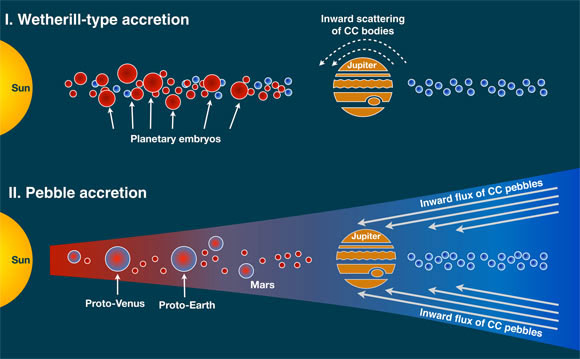Scientists have developed two of the most plausible models regarding how Earth and the rocky planets of the Solar System were formed, uncovering some surprising answers.
According to Sci-News, observational data from other star systems indicate that there are two planet formation processes for a star system structured like our Solar System: divided into the inner Solar System and the outer Solar System, separated by the giant planet Jupiter.

2 models of Earth and rocky planet formation. The first model (above) has been proven to be more accurate – (Photo: Lawrence Livermore National Laboratory)
In the first model, developed by a team led by the Nuclear Science and Chemistry Division at the Lawrence Livermore National Laboratory (USA), the inner Solar System contains numerous primordial planetary embryos. These embryos collide, break apart, and reassemble, ultimately forming the four inner rocky planets: Mercury, Venus, Earth, and Mars.
In the second model, the protoplanets are relatively small and are later built up by material flowing in from the outer Solar System, spilling over Jupiter’s orbit and gradually accumulating to form the four planets as we know them today.
To determine which scenario is accurate for the Solar System, researchers traced the chemical signatures of non-carbonaceous (NC) meteorites and carbonaceous (CC) meteorites. NC meteorites are common in the inner Solar System, while CC meteorites belong to the outer Solar System.
Dr. Jan Render, the lead author of the study, stated that Earth and Mars were selected for compositional analysis. The isotopic variations indicate that both planets incorporated material from the two types of meteorites, but primarily from NC meteorites, with only a small amount of CC meteorites.
This suggests that the first model is more accurate. Earth is indeed the result of the reassembly of many planetary embryos—those “young planets” of the primordial Solar System. It received a slight addition of CC meteorites, but only a few accidentally drifted into the inner Solar System.
The results have just been published in the journal Science Advances.


















































